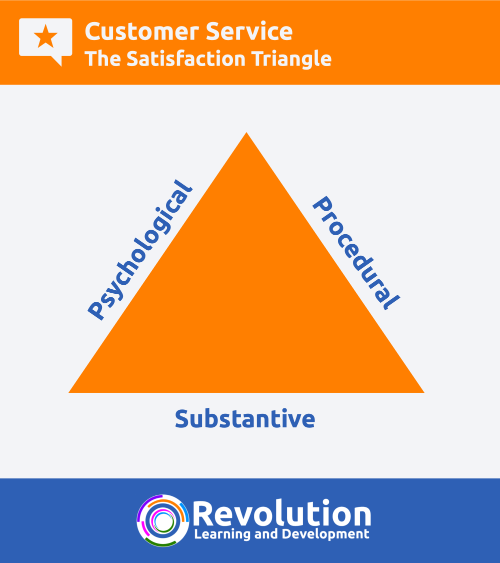Background
The satisfaction triangle helps us to understand what customers need to feel when they make a complaint. It’s a great way of ensuring that we can deliver a great customer experience, even when a customer is complaining.
When a customer makes a complaint, they need to feel certain things in order to feel satisfied that the complaint is being dealt with correctly and that it’s brought to a full conclusion. If they feel the right things, it means fewer return visits, calls or emails about the issue and leaves them feeling more positive about the company they have complained to.
The Satisfaction Triangle
The satisfaction triangle suggests that customer needs to have 3 things satisfied when making a complaint. These are:
- Psychological satisfaction
- Procedural satisfaction
- Substantive satisfaction

- Psychological Satisfaction – providing the customer with the feeling that their complaint has been heard and taken seriously, no matter how trivial it is.
- Procedural Satisfaction – helping the customer understand how their complaint will be handled and your steps.
- Substantive Satisfaction – providing or demonstrating that there is an outcome or their complaint has made a difference.
Psychological Satisfaction
The first part of the satisfaction triangle is psychological satisfaction. This is providing the customer with the feeling that their complaint has been heard and taken seriously, no matter how trivial it is.
Despite what we think of it, the thing the customer is complaining about is important to them and as such, we need to help see that we feel the same way too.
We can demonstrate psychological satisfaction by:
- Choosing a positive attitude towards helping the customer
- Not responding defensively
- Carefully choosing the body language, tone of voice and words that we use
- Asking questions to understand the background and show genuine interest
- Showing that you have listened to what has been said
- Demonstrating empathy where this is appropriate
- Use the term “I” rather than “we”
When we strive to provide psychological satisfaction, even the angriest of customers will begin to change their position. This is especially true when we ask questions as this forces them to think more logically about the answers they provide, rather than communicating through the emotions that they are feeling.
Procedural Satisfaction
The second part of the satisfaction triangle is procedural satisfaction. This is ensuring the customer understands how their complaint will be handled and the steps you will take to resolve it.
When a customer doesn’t know what’s going on, they tend to feel more frustrated and this causes them to revisit or call or email again for a follow-up.
Ensuring the customer understands the process leaves them with a better understanding of what is happening and helps them feel more satisfied that things are being taken care of.
We can demonstrate psychological satisfaction by:
- Providing a clear description of the steps you will take next and how long each will take
- Provide specific dates and times and avoid terms like “as soon as possible” or “as quickly as I can”
- If you have a complaints procedure, point them in the direction of this or send them a copy
Substantive Satisfaction
The third part of the satisfaction triangle is substantive satisfaction. This is where we show the customer that there is an outcome to their complaint or their complaint has made a difference.
We often assume that customers complain because they want something, for example, compensation. This isn’t always the case though and we can be too quick to offer them something in the hope they go away.
First and foremost, the customer wants their issue resolved. If we don’t do this, offering compensation may end the complaint, but it won’t leave them feeling positive about us or our company.
All of our focus should be on getting as much of the issue fixed as possible. Then, we can start to think about the outcome.
For a lot of customers, the very fact we have addressed their complaint is enough. If we can help them to see how their complaint means the same thing won’t happen to others, even better.
We can demonstrate substantive satisfaction by:
- Thanking the customer for providing us with the opportunity to put their problem right
- Providing a clear description of the outcomes of the complaint
- Describe what actions will be taken to ensure the problem isn’t repeated for them or other customers
- As the customer what would be a good outcome for them
- Address any requests for compensation/refunds only after a full investigation has been carried out
As you can see, there are lots of other things that can be done here other than just offering compensation.
Further Learning
We cover more about the satisfaction triangle and many other tips and ideas on handling customer complaints in our complaints handling training course. See the Customer Complaints Handling course page for more details.



